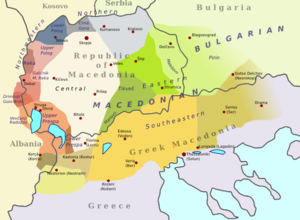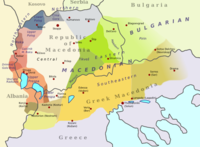
The Skopje-Veles dialect (Macedonian: Скопско-велешки дијалект, Skopsko-veleški dijalekt) is a member of the central subgroup of the Western group of dialects of Macedonian. The dialect is spoken by a larger group of people in the cities Skopje and Veles and in the surrounding villages: Volkovo, Katlanovo, Petrovec and Čaška among others. This dialect is of historical importance for Macedonian because it is considered by many to be a prestige dialect.[citation needed] On August 2, 1945, the Skopje-Veles dialect, together with the other dialects of the central group was officially regulated as a basis of standard Macedonian. Many Macedonian writers and linguists were writing on this dialect and considered it to be standard Macedonian.[citation needed] One of them was Krste Petkov Misirkov and in his book For Macedonian affairs wrote that this dialect should be standard Macedonian. He has been writing on Skopje-Veles dialect and on Prilep-Bitola dialect.[1]
Internal migration to the capital Skopje in the 1950s and 1960s led to the development of a new, urban slang where newly arrived people attempted to incorporate elements of the Skopje-Veles dialect into their own speech, often confusing local elements with those from Serbo-Croatian. Language contact with Serbo-Croatian, then a more prestigious language in SFR Yugoslavia, also reached its height during this period. This variety has been described as a "creolized form of Serbian"[2] (cf. also Surzhyk in Ukraine, Trasianka in Belarus) and is distinct from the 'authentic' Skopje-Veles dialect.
Phonological characteristics
- use of /v/ instead of the archaic /x/: страх (strah) > страв (strav; 'fear');
- emphasis mostly on the antepenultimate syllable in Veles, and less in Skopje;
- use of the hard (palatal) l;
- use of intervocal /v/: човек (čovek; 'man');
- use of the hard sound њ (nj) (in the other dialects of the central group this sound is soft);
- use of the letter ќ and ѓ (in the others dialects of the central group the cluster јќ and јѓ is found): куќа (kuḱa) – кујќа (kujḱa; 'house').
Morphological characteristics
- use of the preposition во (vo) or в (v);
- use of the grammatical construction have + past participle: имам работено (imam raboteno; 'I have worked');
- use of three articles.
Examples of the Skopje-Veles dialect
The poem "A voice from Macedonia" by Kole Nedelkovski is probably one of the most famous texts written in the Skopje-Veles dialect.
|
О, трајте, трајте, тирани недни! |
O, trajte, trajte, tirani nedni!
|
- Skopje dialect
И кога о́тишол та́му, прет ку́ќата и́мало една‿ја́бука. И се‿ка́чил на ја́буката. И‿иско́чило ла́мн’ичето и ви́ка: „И, ма́мо, ка́коф сра́шен ју́нак има на ја́буката“. „Ка́ко ги‿ја́де, ќе́рко, ја́буките, а́ли со‿све‿ли́стот, а́ли ѓи‿о́дбира“? „Не‿ѓи‿о́дбира, не́“. „Е, не‿е сра́шен за‿на́с, ви́кни‿го‿ва́му“. Коа‿го‿ви́кнале та́му, и‿о́на ту́рила сла́ма да‿за́пали о́ѓин да‿му‿на́прави ве́чера, и му‿ви́ка: „Наве́дни‿се‿ју́наче“. Он се‿на́веднал и‿о́на го‿га́лтнала. И‿и́сто и‿со‿фто́ријот бра́т та́ка. И ќе́лчо че́кал, че́кал, бра́ќава ѓи‿не́ма. Ќи́нисал да‿и́де и о́н. И‿го‿сре́тнал симиџи́јата и му‿ви́ка: „Ка́де, бре‿ќе́лчо“? „У‿то́ва се́ло и́ма една‿ла́мн’а, ќ‿и́дам да‿ја‿уте́пам...[3]
- Veles dialect
Еден та́тко си‿и́мал тро́јца си́нови. Сино́вите ре́кле: „Та́тко, ве́днага са́каме да‿не‿же́ниш“. Он им‿ре́кол: „Зе́мете по‿е́дно ста́пче, фрлете од‿ри́дот, и на‿ко́ја ку́ќа ќе‿ви‿па́дне, от‿ту́ка не́веста ќе‿зе́мете“. Фрли ста́риот, у‿а́рна ку́ќа му‿се‿по́годи; фрли среѓниот, и‿не́му та́ка, а‿на‿ма́лиот мо́ре. Два́јцата бра́ќа би́ле сре́ќни, а‿во́ј на́јмалиов не́среќен. Се́днал на‿кра́ј на‿мо́рето и‿му‿ка́жује на‿го́спода: „Го́споди, што́ ќе‿зе́мам од‿мо́ре, цел све́т да‿ми‿се‿сме́е“. Бра́ќата си‿ги‿зе́доја неве́стите и‿се́а ќе‿о́дат да‿ви́дат шо ќе‿зе́ме ма́лиот. Оти́доа до‿мо́ре и‿ги‿пу́штија чинѓе́лите за‿со‿ни́м не́што да‿изма́кнат. Во мо́рето и́мало една‿ма́јка и‿ќе́рка. Ма́јката си‿ја‿че́шла ќе́рката и му‿ви́ка на‿свато́вите: „Кре́нете‿си‿ги чинѓе́лите, не‿сме‿ста́сани“...[3]
References
- ^ Koneski, Blaže (Блаже Конески) (1967). Gramatika na makedonskiot literaturen jazik Граматика на македонскиот литературен јазик (in Macedonian). Skopje: Kultura. pp. 68–69.
- ^ Kortmann, Bernd; Auwera, Johan van der, eds. (2011). The Languages and Linguistics of Europe: A Comprehensive Guide. Berlin: Walter de Gruyter. p. 420. ISBN 978-3110220261.
- ^ a b Bojkovska, Stojka (Стојка Бојковска); Minova-Ǵurkova, Liljana (Лилјана Минова – Ѓуркова); Pandev, Dimitar (Димитар Пандев); Cvetkovski, Živko (Живко Цветковски) (2008). Dimitrova, Savetka (Саветка Димитрова) (ed.). Opšta gramatika na makedonskiot jazik Општа граматика на македонскиот јазик (in Macedonian). Skopje: AD Prosvetno delo. pp. 436–437. OCLC 888018507.


